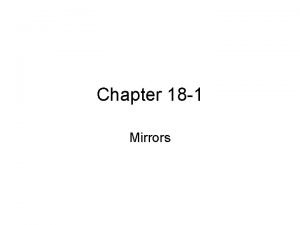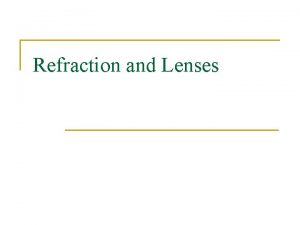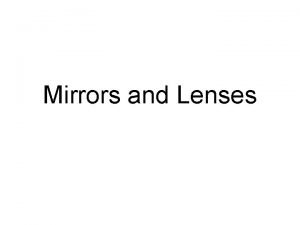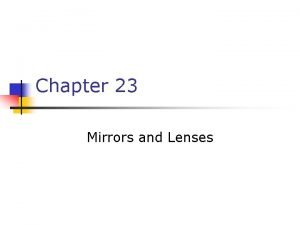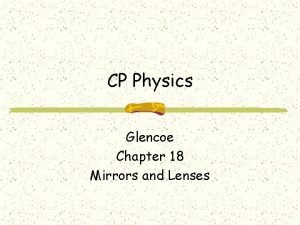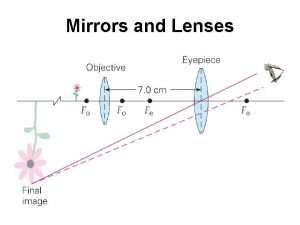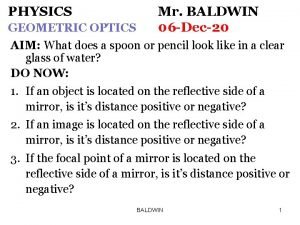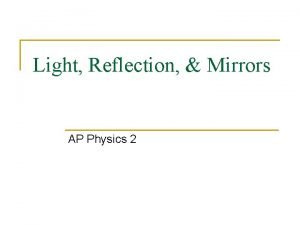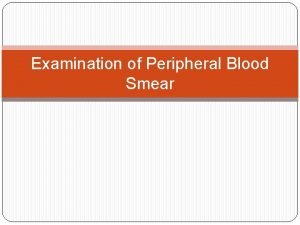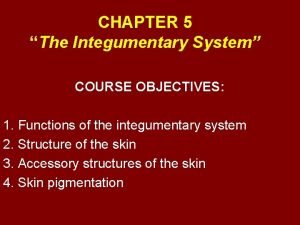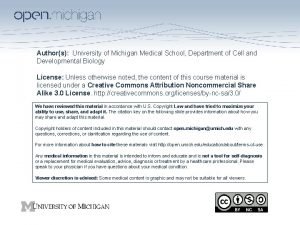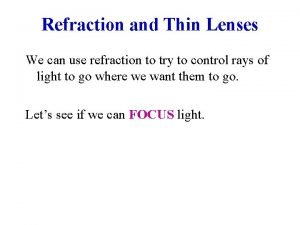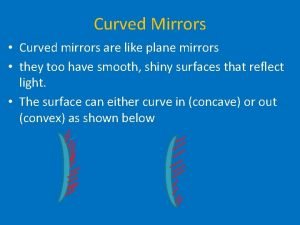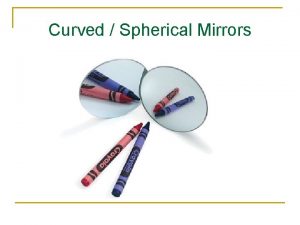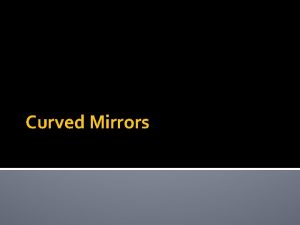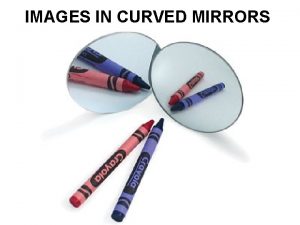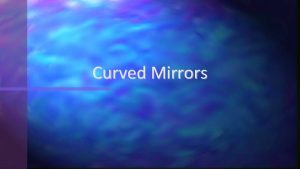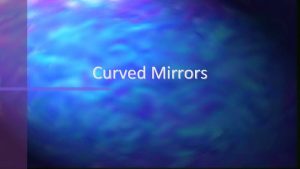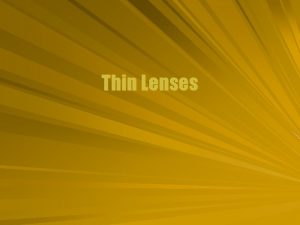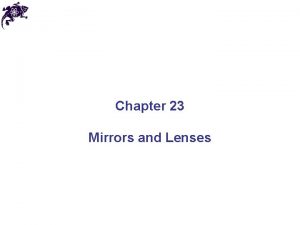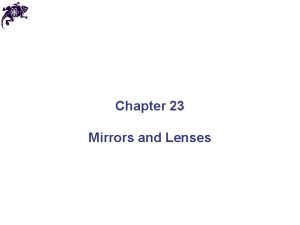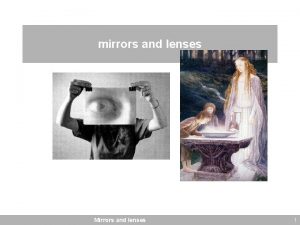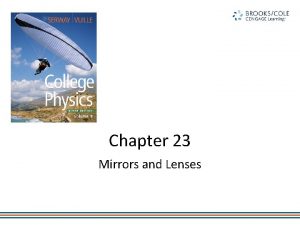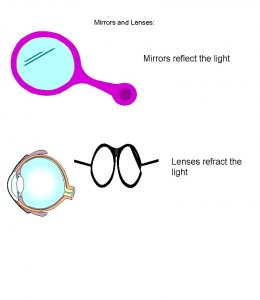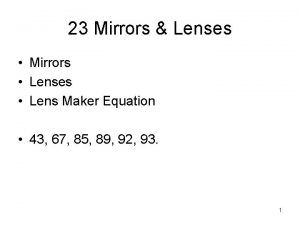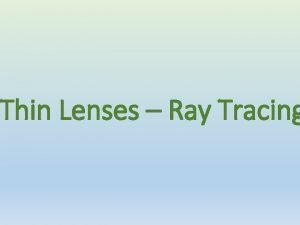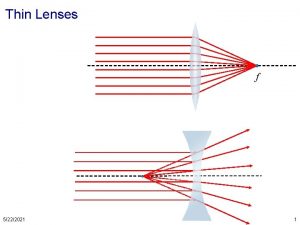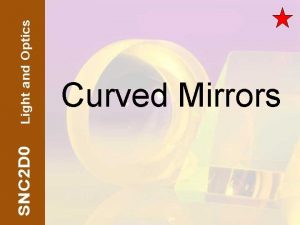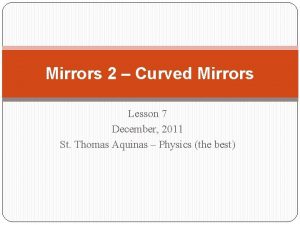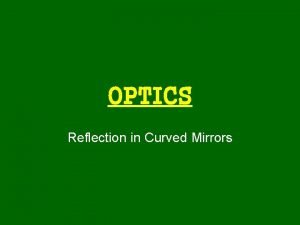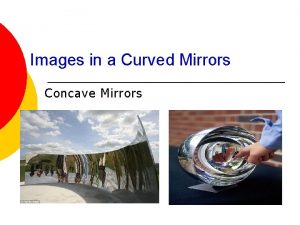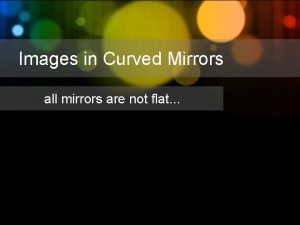Curved mirrors thin thick lenses and cardinal points

























- Slides: 25

Curved mirrors, thin & thick lenses and cardinal points in paraxial optics Hecht 5. 2, 6. 1 Monday September 16, 2002

General comments Welcome comments on structure of the course. n Drop by in person n Slip an anonymous note under my door n… n

Reflection at a curved mirror interface in paraxial approx. y φ C O ’ I s’ s

Sign convention: Mirrors n Object distance ¨S >0 for real object (to the left of V) ¨ S<0 for virtual object n Image distance ¨ S’ > 0 for real image (to left of V) ¨ S’ < 0 for virtual image (to right of V) n Radius ¨R > 0 (C to the right of V) ¨ R < 0 (C to the left of V)

Paraxial ray equation for reflection by curved mirrors In previous example, So we can write more generally,

Ray diagrams: concave mirrors Erect Virtual Enlarged C ƒ e. g. shaving mirror What if s > f ? s s’

Ray diagrams: convex mirrors Calculate s’ for R=10 cm, s = 20 cm Erect Virtual Reduced ƒ s s’ C What if s < |f| ?

Thin lens First interface Second interface

Bi-convex thin lens: Ray diagram Erect Virtual Enlarged I O f f‘ n n’ R 1 s s’ R 2

Bi-convex thin lens: Ray diagram R 1 R 2 Inverted Real Enlarged O n I f f‘ n’ s s’

Bi-concave thin lens: Ray diagram O I f f‘ n’ n s Erect Virtual Reduced R 1 s’ R 2

Converging and diverging lenses Why are the following lenses converging or diverging? Converging lenses Diverging lenses

Newtonian equation for thin lens R 1 R 2 O f n f‘ x’ n’ s s’ I x

Complex optical systems Thick lenses, combinations of lenses etc. . Consider case where t is not negligible. n We would like to maintain our Gaussian imaging relation n’ t n. L But where do we measure s, s’ ; f, f’ from? How do we determine P? We try to develop a formalism that can be used with any system!!

Cardinal points and planes: 1. Focal (F) points & Principal planes (PP) and points n n. L n’ F 2 H 2 ƒ’ PP 2 Keep definition of focal point ƒ’

Cardinal points and planes: 1. Focal (F) points & Principal planes (PP) and points n n. L F 1 H 1 ƒ PP 1 Keep definition of focal point ƒ n’

Utility of principal planes Suppose s, s’, f, f’ all measured from H 1 and H 2 … n h n. L n’ F 1 F 2 H 1 H 2 h’ ƒ’ ƒ s s’ PP 1 PP 2 Show that we recover the Gaussian Imaging relation…

Cardinal points and planes: 1. Nodal (N) points and planes n n’ N 1 N 2 n. L NP 1 NP 2

Cardinal planes of simple systems 1. Thin lens V’ and V coincide and V’ V H, H’ is obeyed. Principal planes, nodal planes, coincide at center

Cardinal planes of simple systems 1. Spherical refracting surface n n’ Gaussian imaging formula obeyed, with all distances measured from V V

Conjugate Planes – where y’=y n y n. L n’ F 1 F 2 H 1 H 2 y’ ƒ’ ƒ s s’ PP 1 PP 2

Combination of two systems: e. g. two spherical interfaces, two thin lenses … n H 1 ’ n 2 H’ n’ h’ H 2 ’ 1. Consider F’ and F 1’ y Find h’ Y F’ d ƒ’ ƒ 1’ F 1 ’

Combination of two systems: h Find h H 1 H 2 ’ H H 1 ’ Y F 2 y F ƒ d ƒ 2 n 1. Consider F and F 2 n’

Summary H H’ H 1 ’ H 2 ’ F F’ d ƒ h h’ ƒ’

Summary
 Plane and curved mirrors
Plane and curved mirrors Mirror lens equation
Mirror lens equation Mirrors and lenses
Mirrors and lenses Mirrors and lenses
Mirrors and lenses Physics classroom lenses and mirrors
Physics classroom lenses and mirrors Mirror and lens equation
Mirror and lens equation Sign convention table for mirrors and lenses
Sign convention table for mirrors and lenses Ap physics 2 mirrors and lenses
Ap physics 2 mirrors and lenses Concave mirror salt
Concave mirror salt Trypanosoma bruzi
Trypanosoma bruzi Thick skin
Thick skin Parasite in blood smear
Parasite in blood smear Thin and thick smear
Thin and thick smear Field stain procedure for malaria
Field stain procedure for malaria Thick and thin questions examples
Thick and thin questions examples Thick and thin film ic
Thick and thin film ic Thin skin vs thick skin
Thin skin vs thick skin Thick vs thin skin
Thick vs thin skin Thick vs thin skin
Thick vs thin skin Example of two tier architecture
Example of two tier architecture Thick or thin skin
Thick or thin skin Refraction in thin lenses
Refraction in thin lenses Coleridge biographia literaria chapter 14 summary
Coleridge biographia literaria chapter 14 summary Cardinal points worksheet
Cardinal points worksheet Four cardinal points
Four cardinal points Cardinal points
Cardinal points
